Notes: Johnstown & Hafod was located on the Great Western Railway’s (GWR) main line that linked Birmingham to the River Mersey at Birkenhead via Chester. The section of line on which the station was situated had been opened by the Shrewsbury & Chester Railway (S&CR) on 4 November 1846. At that time it stretched only from Saltney Junction (near Chester) and a temporary station at Rhosymedre on the north side of the Vale of Llangollen. Almost two years later on 14 October 1848 the Rhosymedre to Shrewsbury section opened. The S&CR was taken over by the Great Western Railway (GWR) on 1 September 1854 (Click here to read more about the S&CR and the GWR take over) thereby creating a route to the north for that company.
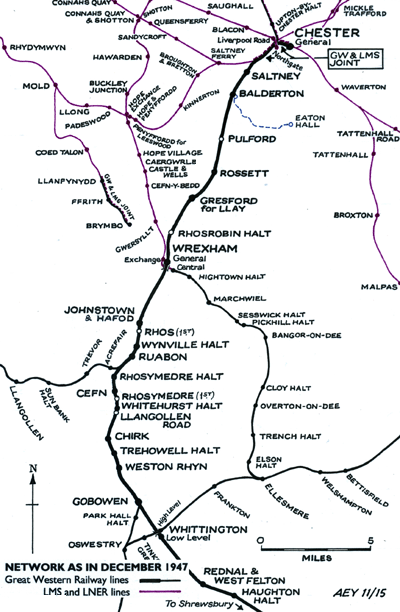 Johnstown & Hafod was opened by the GWR on 1 June 1896 to serve the settlement of Johnstown which lay to the west and Hafod which lay to the north-east. At Hafod there was a colliery that had opened in 1867 (originally called Ruabon New Colliery and later Hafod-y-Bwch) and the station was ideally situated to serve its employees. Johnstown & Hafod was opened by the GWR on 1 June 1896 to serve the settlement of Johnstown which lay to the west and Hafod which lay to the north-east. At Hafod there was a colliery that had opened in 1867 (originally called Ruabon New Colliery and later Hafod-y-Bwch) and the station was ideally situated to serve its employees.
The station was located on north side of Banger Road over which the line passed on a bridge. It was located on an embankment and was reached by sloping pathways.
The main facilities were on the down platform (Chester direction). The single-storey brick building with a hipped slate route was unassuming and lacked ornamentation. However an awning with a serrated valance, placed so as to continue the downward slope of the pitched roof, added both to the character of the building and the comfort of the waiting passengers. A small extension was added at the southern end, constructed of timber. The up platform (Shrewsbury) building, also with an awning, closely resembled its larger neighbour standing opposite on the Chester-bound platform.
A short distance north of the station was a junction, controlled by Johnstown & Hafod signal box, from which a branch ran into the colliery. Colliery sidings extended to the rear of the north end of the up platform.
.gif) The line through Johnstown & Hafod station saw express passenger (including the GWRs illustrious London Paddington – Birkenhead Woodside service) and semi-fast passenger services, as well as the local passenger services which generally called at the station. The line was also an important freight artery. With traffic also running into and out of the colliery Johnstown & Hafod station would have been very busy with train movements. Passenger numbers however were not great. In 1903 17,899 tickets were sold at Johnstown & Hafod and 2,318 parcels were handled. Because of the colliery 117,794 tons of coal was handled at Johnstown & Hafod. The line through Johnstown & Hafod station saw express passenger (including the GWRs illustrious London Paddington – Birkenhead Woodside service) and semi-fast passenger services, as well as the local passenger services which generally called at the station. The line was also an important freight artery. With traffic also running into and out of the colliery Johnstown & Hafod station would have been very busy with train movements. Passenger numbers however were not great. In 1903 17,899 tickets were sold at Johnstown & Hafod and 2,318 parcels were handled. Because of the colliery 117,794 tons of coal was handled at Johnstown & Hafod.
From 4 April 1903 the Wrexham & District Electric Tramway Co operated an electric tram service between Johnstown and Wrexham. The trams were much more convenient than the trains as they ran from the centre of Johnstown into the centre of Wrexham. To counter the competition on 5 June 1905 the GWR opened a rail-motor halt in Johnstown called Ponkey Crossing Halt. It was less than a mile west of Johnstown & Hafod station and located on an industrial branch that had opened on 1 August 1868 (and which was extended northwards in August 1876 and in June 1905). The halt was adjacent to the tram terminus. The rail-motor service to Ponkey Crossing Halt was not a success and it ceased on 22 March 1915. These events were not helpful to the fortunes of Johnstown & Hafod station which held an advantage only in terms of colliery workers as it was much closer to the mine than the tramway or the Ponkey branch.
The July 1922 timetable showed 11 up and 12 down services on Monday-to-Saturday. There were three up and two down trains on Sunday.
.gif) In 1923 12,339 tickets were sold and 2,139 parcels handled. The amount of coal handled had risen to 204,041 tons. In 1923 12,339 tickets were sold and 2,139 parcels handled. The amount of coal handled had risen to 204,041 tons.
The electric tram service between Johnstown and Wrexham ran for the last time on 31 March 1927. It is doubtful whether this made much difference to passenger numbers at Johnstown & Hafod station as the trams were replaced with a bus service.
In 1933 only 4,975 tickets were sold; less than half the number of a decade earlier. Parcel traffic had increased with 3,012 being handled but coal handled had dropped to 121,733 tons.
On 1 January 1948 Johnstown & Hafod became part of British Railways [Western Region] (BR[WR]). The summer timetable for 1949 showed 14 up and 12 down Monday-to-Saturday services as seen in the table below. No trains called on Sunday.
Up Trains Summer 1949 |
Destination |
Down Trains Summer 1949 |
Destination |
6.40am |
Oswestry |
8.15am |
Chester General |
7.55am |
Shrewsbury |
8.42am |
Chester General |
9.19am |
Barmouth |
10.00am |
Chester General |
11.46am |
Oswestry |
11.17am |
Wrexham General |
1.13pm |
Bala |
1.14pm |
Wrexham General |
1.57pm |
Pwllheli |
2.51pm |
Chester General |
3.50pm |
Bala |
4.48pm |
Wrexham General |
4.59pm |
Llangollen |
5.27pm |
Chester General |
5.46pm |
Gobowen |
6.59pm |
Wrexham General |
6.30pm |
Barmouth |
7.59pm |
Wrexham General |
7.01pm |
Birmingham Snow Hill |
9.35pm |
Wrexham General |
8.02pm |
Gobowen |
10.27pm |
Wrexham General |
9.26pm (Saturdays Excepted) |
Bala |
|
|
9.51pm (Saturdays Only) |
Bala |
|
|
10.39pm |
Oswestry |
|
|
From 1 June 1955 Johnstown & Hafod station ceased to be staffed; the suffix ‘Halt’ was added both in the timetable and on the running-in nameboards. The 15 September 1958 timetable showed only six up and four down services Monday-to-Saturday. By this time Johnstown & Hafod was proving to be unremunerative and BR[WR] closed it on 12 September 1960 along with 12 other intermediate stations and halts between Chester and Shrewsbury. The platforms and buildings survived for a few years in a derelict condition but by the 1970s the station had been demolished.
The line became part of BR London Midland Region on 17 June 1963 and in March 1967 they withdrew the London – Birkenhead expresses and many other main line services that ran along the former S&CR.
Hafod-y-Bwch colliery closed on 9 March 1968. The signal box that had controlled the junction with the colliery branch closed shortly afterwards.
By the 1970s the line had become a shadow of its former self with only an hourly DMU service on weekdays and a very infrequent service on Sundays. The 21st century saw an upturn in its fortunes with investment being made by the Welsh Assembly Government which enabled a more frequent train service to run.
Tickets from Michael Stewart and route map by Alan Young
Sources:
- A Regional History of the Railways of Great Britain - Volume II North & Mid Wales - Peter E Baughan - David & Charles 1980.
- Encyclopaedia of British Railway Companies - Christopher Awdry - Guild Publishing 1990.
- Paddington to the Mersey - Dr R. Preston Hendry & R. Powell Hendry - Oxford Publishing Company 1992.
- Railway Passenger Stations in Great Britain - a Chronology - Michael Quick - Railway & Canal Historical Society 2009.
To see the
other stations that have closed on the Shrewsbury - Chester General line
click on the station name: Shrewsbury S&C, Leaton, Oldwoods Halt, Baschurch, Stanwardine Halt, Haughton Halt, Rednal & West Felton,
Whittington Low Level, Weston Rhyn, Trehowell Halt, Llangollen Road, Whitehurst Halt, Rhosymedre, Cefn, Rhosymedre Halt, Wynnville Halt, Rhos, Rhosrobin Halt, Gresford, Rossett, Pulford, Balderton and Saltney |




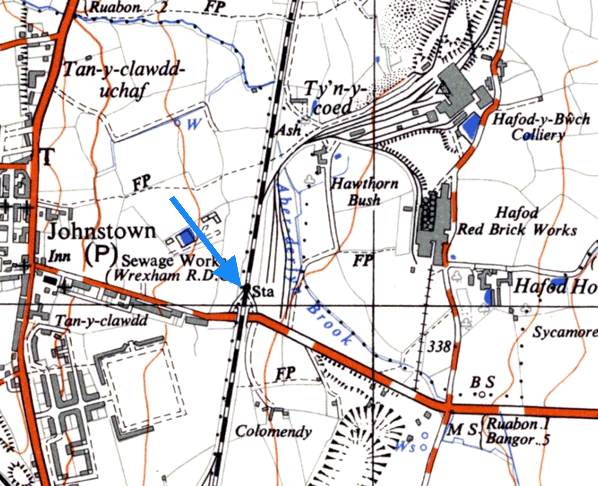
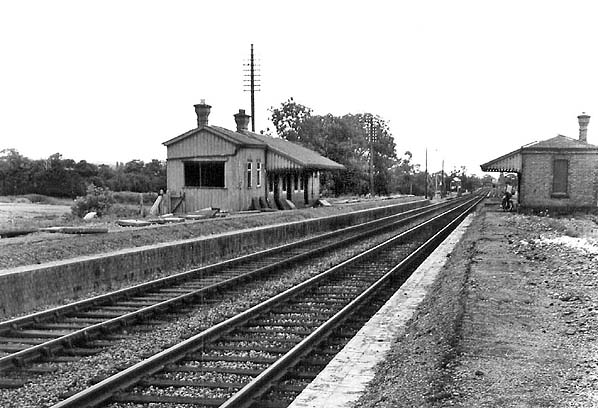
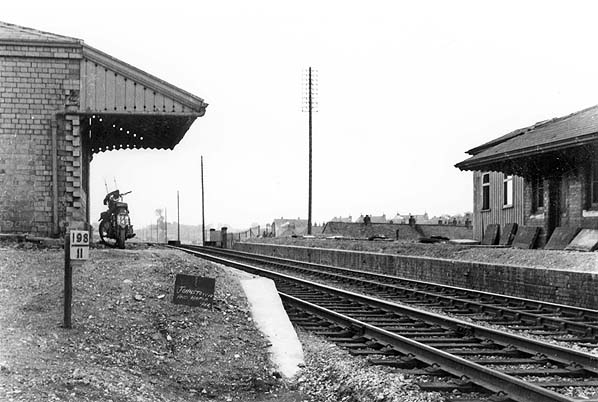
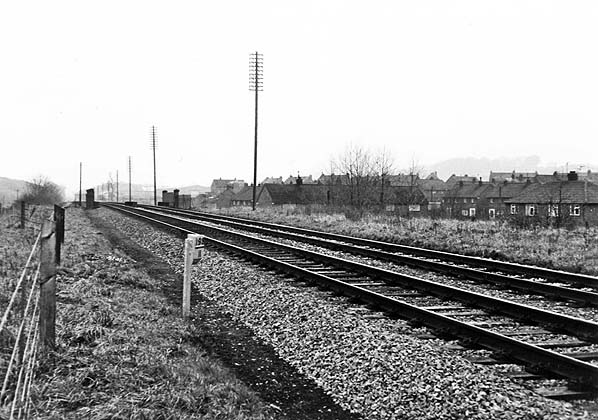
.jpg)
.jpg)
.jpg)
.jpg)
 Johnstown & Hafod was opened by the GWR on 1 June 1896 to serve the settlement of Johnstown which lay to the west and Hafod which lay to the north-east. At Hafod there was a colliery that had opened in 1867 (originally called Ruabon New Colliery and later Hafod-y-Bwch) and the station was ideally situated to serve its employees.
Johnstown & Hafod was opened by the GWR on 1 June 1896 to serve the settlement of Johnstown which lay to the west and Hafod which lay to the north-east. At Hafod there was a colliery that had opened in 1867 (originally called Ruabon New Colliery and later Hafod-y-Bwch) and the station was ideally situated to serve its employees. .gif) The line through Johnstown & Hafod station saw express passenger (including the GWRs illustrious London Paddington – Birkenhead Woodside service) and semi-fast passenger services, as well as the local passenger services which generally called at the station. The line was also an important freight artery. With traffic also running into and out of the colliery Johnstown & Hafod station would have been very busy with train movements. Passenger numbers however were not great. In 1903 17,899 tickets were sold at Johnstown & Hafod and 2,318 parcels were handled. Because of the colliery 117,794 tons of coal was handled at Johnstown & Hafod.
The line through Johnstown & Hafod station saw express passenger (including the GWRs illustrious London Paddington – Birkenhead Woodside service) and semi-fast passenger services, as well as the local passenger services which generally called at the station. The line was also an important freight artery. With traffic also running into and out of the colliery Johnstown & Hafod station would have been very busy with train movements. Passenger numbers however were not great. In 1903 17,899 tickets were sold at Johnstown & Hafod and 2,318 parcels were handled. Because of the colliery 117,794 tons of coal was handled at Johnstown & Hafod. .gif) In 1923 12,339 tickets were sold and 2,139 parcels handled. The amount of coal handled had risen to 204,041 tons.
In 1923 12,339 tickets were sold and 2,139 parcels handled. The amount of coal handled had risen to 204,041 tons..gif)
.gif)

 Home Page
Home Page